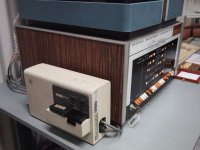Hi,
I would like to start executing some test programs like D0AB, D0BB and D0CC but I'm not sure how to do it. I'll be using a PC with serial port and Tera Term.
Is this the correct way of uploading them?
1- Key in RIM loader (there seems to be 2 versions, high speed and low speed? not sure which one to use)
2- Load address 7756
3- CLEAR and CONT
4- Send BIN Loader using Tera Term as binary file
5- When it finishes uploading the BIN loader, HALT and then check if it is in memory
6- Set address 7777
7- CLEAR and CONT
8- Send test tape in binary format againt using Tera Term as binary file
9- Wait until the file is uploaded and then hit HALT ??
10- Go to the starting address of the test tape and set the switch register as requiered ??
11- CLEAR and CONT
Thanks!
I would like to start executing some test programs like D0AB, D0BB and D0CC but I'm not sure how to do it. I'll be using a PC with serial port and Tera Term.
Is this the correct way of uploading them?
1- Key in RIM loader (there seems to be 2 versions, high speed and low speed? not sure which one to use)
2- Load address 7756
3- CLEAR and CONT
4- Send BIN Loader using Tera Term as binary file
5- When it finishes uploading the BIN loader, HALT and then check if it is in memory
6- Set address 7777
7- CLEAR and CONT
8- Send test tape in binary format againt using Tera Term as binary file
9- Wait until the file is uploaded and then hit HALT ??
10- Go to the starting address of the test tape and set the switch register as requiered ??
11- CLEAR and CONT
Thanks!

